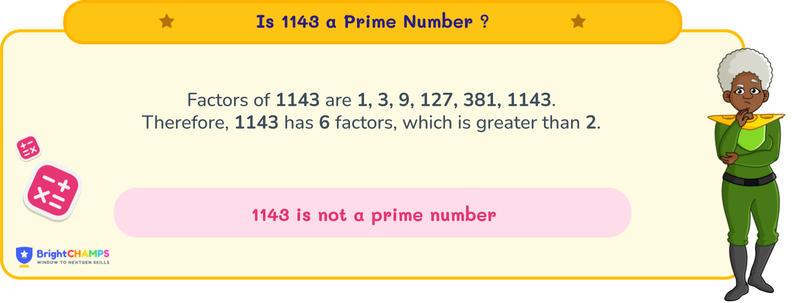Summarize this article:
 199 Learners
199 LearnersLast updated on August 5, 2025
Is 1143 a Prime Number?

Prime numbers are numbers that have only two factors: 1 and themselves. They are integral to fields such as encryption, computer algorithms, and more. In this topic, we will explore whether 1143 is a prime number.

Is 1143 a Prime Number?
Numbers can be primarily classified as prime or composite based on their factors.
Prime numbers are natural numbers that are divisible only by 1 and themselves.
For instance, 3 is a prime number because it is divisible only by 1 and 3.
Composite numbers have more than two factors.
For example, 6 is divisible by 1, 2, 3, and 6, making it a composite number.
Key properties of prime numbers include:
- Prime numbers are positive and greater than 1.
- 2 is the sole even prime number.
- They have exactly two factors: 1 and the number itself.
- Any two different prime numbers are co-prime since their only common factor is 1.
Since 1143 has more than two factors, it is not a prime number.


Why is 1143 Not a Prime Number?
A prime number has only two divisors: 1 and itself. Because 1143 has more than two factors, it is not prime.
We can determine whether a number is prime or composite using several methods, including:
- Counting Divisors Method
- Divisibility Test
- Prime Number Chart
- Prime Factorization

Using the Counting Divisors Method
This method involves counting the number of divisors to classify numbers as prime or composite. If a number has exactly 2 divisors, it is prime; if it has more, it is composite.
Let's check if 1143 is prime or composite.
Step 1: All numbers are divisible by 1 and themselves.
Step 2: Divide 1143 by 2. It is not divisible by 2, as it is odd.
Step 3: Divide 1143 by 3. The sum of the digits (1 + 1 + 4 + 3 = 9) is divisible by 3, so 1143 is divisible by 3.
Step 4: Check divisors up to the square root of 1143.
Step 5: When dividing 1143 by numbers up to its square root, it is divisible by 3, 381, and other numbers.
Since 1143 has more than 2 divisors, it is a composite number.

Using the Divisibility Test Method
This method uses rules to determine if a number is divisible by another without a remainder.
Divisibility by 2: 1143 ends in 3, which is not even, so it is not divisible by 2.
Divisibility by 3: The sum of the digits is 9, divisible by 3, meaning 1143 is divisible by 3.
Divisibility by 5: The last digit is not 0 or 5, so not divisible by 5.
Divisibility by 7: Double the last digit (3 × 2 = 6), subtract from the rest (114 - 6 = 108), which is divisible by 3, so 1143 is divisible by 7.
Divisibility by 11: The alternating sum of digits (1 - 1 + 4 - 3 = 1) is not divisible by 11. Since 1143 is divisible by numbers other than 1 and itself, it is composite.

Using Prime Number Chart
The prime number chart, created using methods like the Sieve of Eratosthenes, helps identify primes.
Step 1: List numbers from 1 to 100 in a grid.
Step 2: Leave 1 unmarked as it is neither prime nor composite.
Step 3: Mark 2 as prime and cross out multiples.
Step 4: Mark 3 as prime and cross out multiples.
Step 5: Continue marking primes and crossing multiples up to 100.
For numbers larger than 100, like 1143, they must be checked using methods like divisibility tests or factorization since they won't appear on a basic chart. Since 1143 is not prime, it won't appear as a prime number in any extended chart.

Using the Prime Factorization Method
Prime factorization breaks a number into its prime factors, which multiplied together give the original number.
Step 1: Start with the smallest prime, 3: 1143 ÷ 3 = 381.
Step 2: 381 is composite, divide by 3: 381 ÷ 3 = 127.
Step 3: 127 is a prime number. Thus, the prime factorization of 1143 is 3 × 3 × 127.

Common Mistakes to Avoid When Determining if 1143 is Not a Prime Number
Misunderstandings about prime numbers can lead to several common mistakes.

FAQ on is 1143 a Prime Number?
1.Is 1143 a perfect square?
2.What is the sum of the divisors of 1143?
3.What are the factors of 1143?
4.What are the closest prime numbers to 1143?
5.What is the prime factorization of 1143?

Important Glossaries for "Is 1143 a Prime Number"
- Composite numbers: Numbers greater than 1 with more than two factors.
- Prime numbers: Numbers greater than 1 with exactly two distinct factors.
- Divisibility test: Methodologies to determine if one number divides another completely.
- Factors: Numbers that divide a given number without leaving a remainder.
- Prime factorization: Expressing a number as a product of prime numbers.

Explore More numbers
![Important Math Links Icon]() Previous to Is 1143 a Prime Number?
Previous to Is 1143 a Prime Number?
![Important Math Links Icon]() Next to Is 1143 a Prime Number?
Next to Is 1143 a Prime Number?


Hiralee Lalitkumar Makwana
About the Author
Hiralee Lalitkumar Makwana has almost two years of teaching experience. She is a number ninja as she loves numbers. Her interest in numbers can be seen in the way she cracks math puzzles and hidden patterns.
Fun Fact
: She loves to read number jokes and games.




